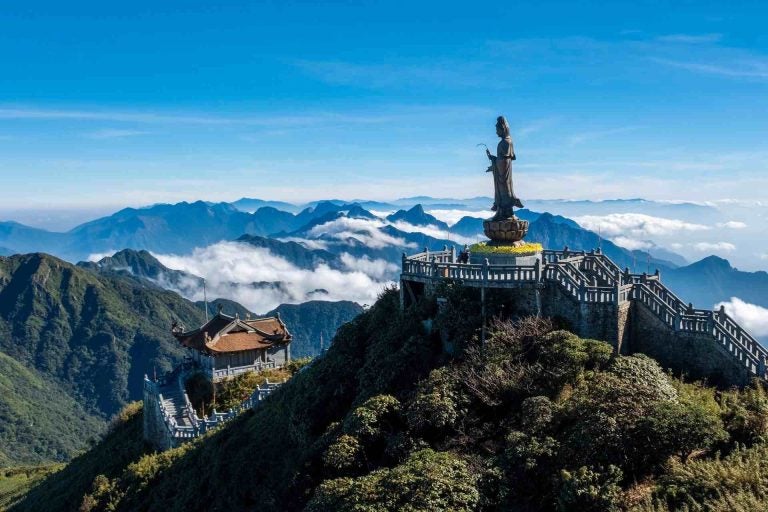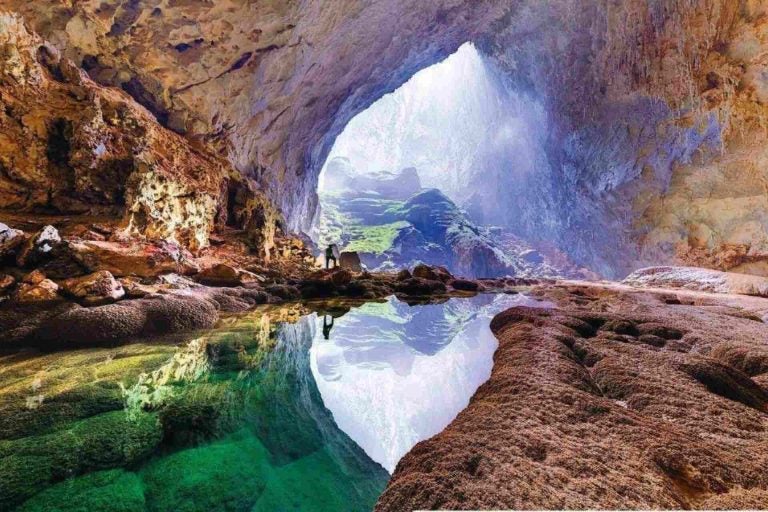Hiking in Vietnam: 9 unforgettable trails to explore
Vietnam offers endless trekking routes spanning from Cat Tien National Park in the South to Ban Gioc Waterfall in the very North. Follow along to learn about the best ones.
If lush jungles, breathtaking landscapes, and rich wildlife sound like your thing, a hiking trip to Vietnam should be on your list. You can choose from short trails that uncover scenic views to lengthy hikes that go off the beaten track and away from the crowds. No matter what you’re looking for, you will find it in the list below.
1. Fansipan, Vietnam’s tallest mountain
Difficulty: Moderate
Time: 16-hour round-trip, 1-2 days for the hike.

Fansipan, located in the Hoang Lien National Park, is the highest peak in Vietnam. Standing at 3,147 meters (10,325 feet) tall, it offers quite the challenge to anyone looking to climb it. While it’s not a super technical hike, the climb is steep and requires good physical fitness. If you don’t feel like hiking, there are cable cars running up to the summit daily.
It takes about 6-8 hours to summit Fansipan, with most hikers splitting the hike into two days. It’s recommended for less-experienced hikers to go with a paid tour to avoid getting lost and to ensure the easiest track to the top. The main overnight camp is located at a height of 2,800 meters, and sleeping there is an experience in itself.
The views at the top overlook the lush landscape of Northern Vietnam. The summit is also famous for a 21-meter-tall bronze statue of the Buddha and additional statues and structures to explore.
2. Sapa Rice terraces
Difficulty: Easy
Time: As much as you want to spend, typically 1-2 days

While you’re in North Vietnam, taking on the challenge of Fansipan, make sure to dedicate some time to the nearby rice terraces surrounding the town of Sapa – you won’t regret it. Rice fields, in general, are an essential part of Vietnamese culture and landscape, and the spectacular mountain views surrounding the rice terraces of Sapa make it even more special.
The ancient villages of Cat Cat, Ta Phin, Y Ty, and Sin Chai, among others, allow you to get to know the local culture and village life while exploring the stunning landscape. Take some time to wander around on foot or get a trekking tour to the most scenic spots.
In general, September and October are considered to be the best times to visit because it’s right before the rice is harvested.
3. Cat Tien National Park
Difficulty: Varies depending on the trail
Time: 2-3 days for exploring

If summiting mountains isn’t exactly your thing, Vietnam offers plenty of lowland treks to explore. The Cat Tien National Park, located about 150 km north of Ho Chi Minh City, is a lush tropical forest with tails running alongside centuries-old trees and vast wildlife.
You can spend weeks exploring the vast area, with Crocodile Lake, Gibbon Loop, and Bat Cave Loop hikes being amongst the most popular. No matter what you do or where you go, make sure to keep looking around. The park is home to multiple species of monkeys, exotic birds, and even the largest population of elephants in Vietnam.
4. Bach Ma National Park
Difficulty: Varies depending on the trail
Time: 1-3 days for exploring

The Bach Ma National Park, located in Central Vietnam, is another nature gem with plenty of hiking opportunities. On top of being home to over 1,500 animal and over 2,000 plant species, it’s famous for its tumbling waterfalls and a generally pleasant climate.
You can start with a simple Vong Hai Dai hike to a peak that overlooks both sides of the park. Other notable hiking trails include the Ngu Ho, Do Quyen Waterfall, and Truc Lam Zen Monastery. If you don’t want the headache of figuring out where to go, you can join one of many Vietnam Trekking Tours offered in the park.
5. Lang Biang Mountain
Difficulty: Moderate
Time: ~4 hours to complete

If you’re going to be visiting Da Lat city, doing the Lang Biang mountain hike is a must. You can explore the Tram Nam Valley on the way there, sample local foods, and coffee farms.
The hike up is quite steep and requires decent physical preparation, though it isn’t a technical climb, so you shouldn’t have any issues if you’re fit enough. If you don’t feel like taking on the roughly four-hour hike, jeeps take tourists up to the summit for an additional fee.
Once there, you’ll be overlooking the city of Da Lat as well as the surrounding mountains, lush hills, and plantations that are an essential part of Vietnam’s scenery.
6. Ban Gioc Waterfall
Difficulty: Easy
Time: 3-4 hours for exploring, several days for tours

The Ban Gioc waterfall, located in the Cao Bang province on the Chinese border, stands out as one of the most beautiful waterfalls in the world, let alone Vietnam. Its remote location means you’ll have to drive or find a tour company to take you there. The two nearest larger cities are Hanoi and Cao Bang, which are 360 km and 90 km away, respectively.
Getting to the waterfall itself isn’t a long hike, as you can drive up pretty close. However, it’s easy to spend hours upon hours just hiking around it and taking in its beauty from different angles.
If you have the time, going on a Ban Gioc waterfall tour is a great option. The multiple-day tour from Hanoi takes you to the Ba Be Lake, the Ngam Ngou cave, and a number of other notable spots outside of the waterfall itself.
7. Phong Nha-Ke Bang National Park
Difficulty: Varies depending on the trail
Time: 1-3 days for exploring

If your goal is to see as many breathtaking spots as possible and not necessarily to walk for hours on end, a visit to the Phong Nha-Ke Bang National Park should be on your list. This UNESCO World Heritage site is famous for its many caves and underground rivers that run crystal clear.
Son Doong Cave, the largest cave in the world, is one of the main attractions here. However, the park has a lot more to offer. There are plenty of trekking opportunities here for visiting dry caves or exploring the lush rainforest. Boat tours that take you through intersecting caves are also a must.
8. Bac Ha
Difficulty: Easy
Time: 1-3 days

Feel like exploring Vietnam’s culture and remote villages on foot? The Bac Ha district is the perfect place to go for that. The district is home to 11 unique tribal villages, each with its own culture and history.
Hiring a local guide is the best way to get actual local knowledge and experience the culture. Take on a multi-day trek through the mountains, visiting as many villages as possible on your way. If you don’t have the time, you can take an easy hike through Fower Hmong and Tay villages, passing some beautiful scenery on the way.
9. Pu Luong
Difficulty: Varies depending on the trail
Time: 1-2 days

With endless plunging green valleys and cascading waterfalls, the Pu Luong Nature Reserve can easily rival Vietnam’s national parks when it comes to sheer beauty and diversity. The trek to Mt. Pu Luong is a hike you won’t want to miss, as it uncovers breathtaking views of the area.
All in all, trekking through the reserve is the best way to experience what it has to offer. You’ll be able to visit multiple ethnic Thai villages, enjoy local foods, and swim under waterfalls. All while being far away from mass tourism and bustling metropolises.
When is the best time to visit Vietnam for hiking?
You’ll want to avoid the rainy season when visiting Vietnam for a hiking trip. With Vietnam being quite a long country, seasonality differs depending on the location:
- Southern Vietnam typically has the most pleasant climate and hiking here is possible all-year-round. That said, March to May tend to be pretty hot, while the rainy season lasts from June to November. December to February usually offers the best weather for hiking.
- Central Vietnam experiences pretty bad storms during the rainy season, so it should be avoided from August to November. March to May is usually the best time, before the weather gets too warm around June.
- Northern Vietnam sees the end of its rainy season around late September, making the time up to mid-November the best for hiking. The nature is lush and green and the weather is pleasantly cool at this time.
How to prepare for hiking in Vietnam
While hiking in Vietnam is exciting, it also requires a bit of preparation and planning in advance. Whether it’s packing your bags or planning your routes, here are some things to consider:
- Don’t try visiting everything. Unless you have months to spend in Vietnam, don’t stuff your schedule with multiple hikes a day or visits in too many different regions. You’ll have a better experience taking everything in slowly instead of rushing through each step.
- Pack comfortable footwear. Hiking in Vietnam includes a lot of walking, with many remote trails to take on. Pack comfortable, worn-in hiking shoes for the trip. Trail runners are perfect for a majority of hikes since they’re not too technical, but any hiking shoes will do as long as they’re comfortable.
- Hire a guide. Hiking solo through the stunning Vietnamese landscape is tempting, but a local guide can significantly enhance your experience with local knowledge and hidden gems you wouldn’t find on your own.
- Stay/get fit. Even though the mountains in Vietnam aren’t the highest, most of them are really steep and require good physical fitness to summit. Make sure to get on a regular exercise schedule before your trip to avoid being overwhelmed.
- Get mobile internet. Having access to mobile internet in Vietnam is a must when traveling. Whether it’s a Vietnam SIM card or eSIM, it helps you find your way around with map apps, communicate with locals using translators, and stay in touch with friends and family while you’re away.
Stay connected with Holafly
Buying travel SIM For Vietnam or renting out pocket WiFi devices in Vietnam may provide mobile internet, but it can’t compete with eSIMs when it comes to convenience, ease-of-use, and affordability.
If you’re looking for the best eSIM for Vietnam, look no further than Holafly. Enjoy having solid coverage throughout the country, 24/7 customer support, and unlimited data for anything you want to do online.





 Language
Language 


















 No results found
No results found













